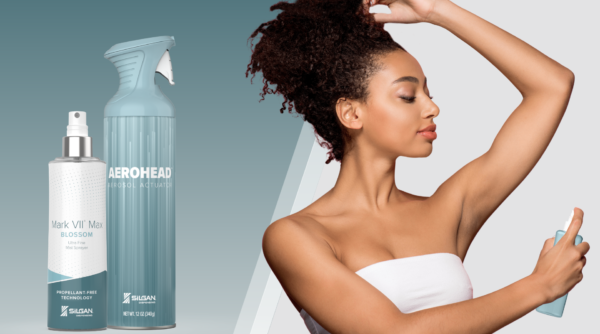
Nel settore dei beni di consumo confezionati (CPG), avere un portafoglio prodotti diversificato consente ai marchi di soddisfare una gamma altrettanto ampia di esigenze dei consumatori. Offrire sia spruzzatori per aerosol sia spruzzatori senza propellente è un ottimo esempio di come si possano sfruttare diverse tecnologie di prodotto per estendere la portata delle preferenze dei consumatori in termini di prestazioni degli spray. Entrambe offrono vantaggi distinti e, nel caso degli atomizzatori a nebbia fine, la tecnologia continua a evolversi in modo da offrire notevoli vantaggi in termini di prestazioni e sostenibilità.
Silgan Dispensing continua ad aggiungere soluzioni prive di propellenti al nostro portafoglio, compresa la nostra ultima offerta, Mark VII® Max Blossom. Di recente abbiamo incontrato Etienne Briere, Senior Manager, Global Fine Mist, Foam, and EU Aerosol, 2cc Dispenser, per parlare dello sviluppo di Blossom e del motivo per cui sempre più consumatori sono alla ricerca di sostituti dei prodotti aerosol. Mark VII® Max Blossom e del motivo per cui un numero sempre maggiore di consumatori cerca di sostituire i prodotti a base di aerosol con quelli a nebbia fine.
Cosa ha portato alla creazione di Mark VII® Max Blossom? Quali sono le esigenze e le tendenze del mercato o dei clienti che Silgan Dispensing intendeva soddisfare con questo prodotto?
I marchi stanno esplorando alternative all'aerosol, dato che le esigenze di erogazione si stanno evolvendo. I prodotti non aerosol, come Mark VII® Max Blossom, sono più facili da trasportare in aereo e possono essere ricaricati, il che risponde a una crescente esigenza di sostenibilità. Inoltre, vediamo che sempre più consumatori si orientano verso prodotti con formulazioni che utilizzano ingredienti naturali. L'aggiunta di un propellente come gli idrocarburi o i gas compressi, che possono emettere COV nell'atmosfera, a un prodotto con ingredienti naturali spesso annulla il vantaggio della sostenibilità per molti.
Ci parli del processo di progettazione, com'è stato?
La sfida principale consisteva nello sviluppare uno spruzzatore a nebulizzazione fine con prestazioni più simili a quelle di un aerosol; in altre parole, aveva un getto di azionamento lungo, un'uscita generosa e la capacità di spruzzare gocce molto piccole per un effetto asciutto a contatto con la pelle.
Dovevamo anche assicurarci che potesse essere prodotto in modo da non incidere negativamente sulla struttura dei costi, rispetto ai prodotti aerosol. Abbiamo effettuato diverse iterazioni, combinando i nostri motori a pompa con le diverse tecnologie di inserti di spruzzatura, al fine di raggiungere un equilibrio tra struttura dei costi e obiettivi di prestazioni di spruzzatura.
Ci parli delle considerazioni sulla sostenibilità di prodotti non aerosol come Mark VII® Max Blossom.
Questo ci riporta all'impulso della sua creazione. Il design non aerosol elimina i propellenti, semplifica il processo di riempimento e consente l'uso di ricariche.
In che modo Mark VII® Max Blossom è paragonabile a uno spray? In cosa è diverso?
La differenza sta più che altro nell'attivazione. Mark VII® Max Blossom offre un'azione prolungata rispetto a quella continua che si ha con gli aerosol. In un certo senso, un'attivazione più lunga può creare un'esperienza di qualità superiore, in quanto si tratta di un'attuazione style più comunemente vista con i prodotti di lusso. Con Blossom, ci proponiamo di offrire questa esperienza premium con una soluzione più accessibile.
Quali tipi di formulazioni o applicazioni sono più adatte ai non-aerosol?
I non aerosol come Blossom sono particolarmente efficaci per le formule liquide. Per esempio, abbiamo misurato grandi prestazioni combinando Blossom con la nuova generazione di deodoranti privi di antitraspiranti nella loro formulazione, come il cloruro di alluminio, un ingrediente controverso in termini di impatto sulla salute.
Abbiamo testato Blossom anche in altre applicazioni, come deodorante per ambienti, fragranza per il corpo, repellente per zanzare e cura delle ferite, con risultati eccellenti.
Quali sono le altre considerazioni che i clienti dovrebbero fare quando decidono tra una soluzione aerosol e una non aerosol?
Il primo aspetto riguarda i costi. Il nostro modello mostra che se si considera il costo totale (non solo il costo dell'imballaggio, ma anche quello del flacone e del riempimento del prodotto), il passaggio da un classico spruzzatore aerosol a uno a nebulizzazione fine come Blossom può offrire un risparmio significativo. Mark VII® Max Blossom può offrire un risparmio significativo. Nell'attuale contesto di inflazione generale, questo è ovviamente un aspetto importante per i nostri clienti.
Poi, guardate il design del packaging. Silgan Dispensing's Mark VII® Max Blossom offre una soluzione che non deve essere assemblata su una lattina di alluminio, poiché il sistema è privo di propellente. Questo apre molte possibilità in termini di design dei flaconi, che non sempre si possono ottenere con gli imballaggi per aerosol, come il PET trasparente o addirittura l'RPET da combinare con Blossom per una soluzione completa . Mark VII Max Blossom per una soluzione completa PCR .
Anche le soluzioni aerosol tradizionali possono svolgere un ruolo nel portafoglio di confezioni di un marchio, soprattutto nelle applicazioni in cui è ideale un volume elevato e/o una nebulizzazione continua. Categorie come le vernici spray, la pulizia di grandi superfici e le applicazioni a lunga distanza per parassiti e giardinieri sono esempi in cui un aerosol tradizionale può essere adatto. Per queste situazioni, i nostri Ergosol® e Aerohead® offrono un'ottima ergonomia e prestazioni di spruzzatura.
***
La scelta tra una soluzione aerosol e una alternativa aerosol dipende dalle esigenze del vostro prodotto e, di conseguenza, da quelle dei vostri consumatori. Alcuni fattori da considerare sono il costo, il design del flacone, l'applicazione, la sostenibilità, ecc. Se avete bisogno di aiuto per decidere, siamo a vostra disposizione.
